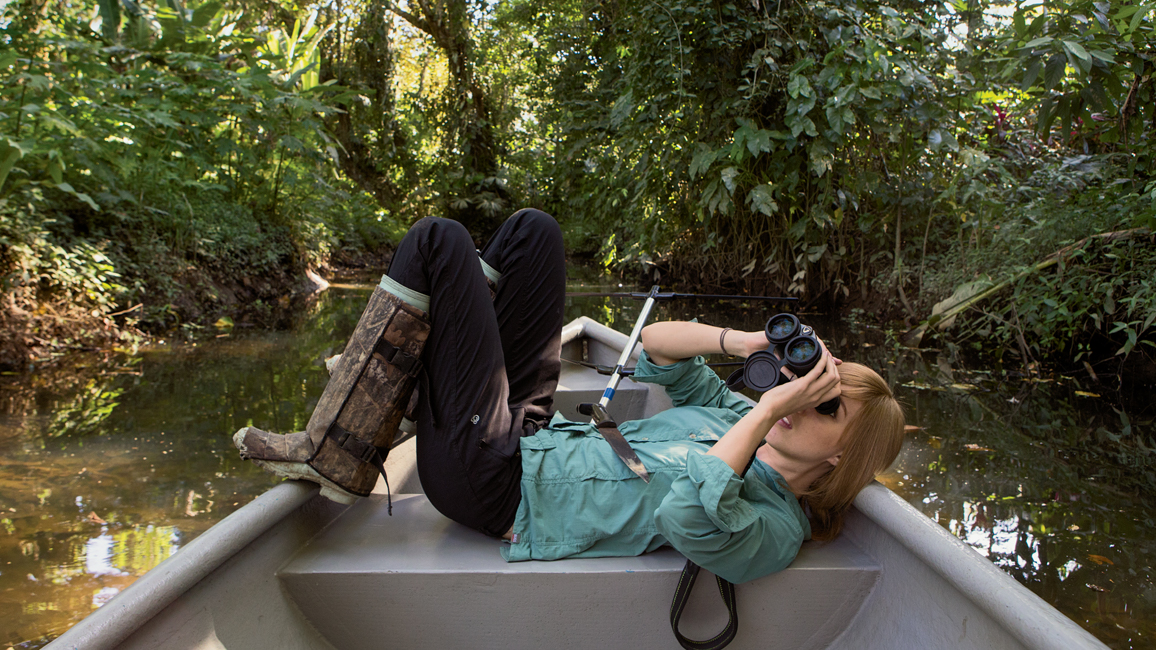
Spying on Sloths
By Hannah Schardt; photos by Suzi EszterhasThanks to high-tech tracking devices, scientists are getting an up-close look at life in the slow lane.
GRAB THOSE BINOCULARS AND LOOK UP, UP, UP.
Who’s that high in a tree in the photo at left? It’s a brown-throated three-toed sloth mom and her baby!
Three-toed sloths are tough to spot. For one thing, they live deep in the forests of Central and South America. For another, their shaggy fur grows a greenish algae (AL-jee) that helps them blend right in with their treetop homes. And, of course, they move sloooowly. So they won’t catch your eye with a flash of movement.
But the scientist below is an expert sloth-spotter. Her name is Rebecca Cliffe, and she knows just where to look: way up high in certain kinds of trees.
Rebecca doesn’t rely just on her binoculars to really get to know wild sloths. She started
a program to fit sloths with special “backpacks.” The packs hold tracking devices that let her follow the critters even when they are out of sight.
Rebecca works in Central America at the Sloth Sanctuary of Costa Rica. When people find sick or injured sloths in the wild, workers at the sanctuary take them in and nurse them back to health. They also raise baby sloths that have lost their moms.
Sick or injured sloths usually can be released back into the wild once they get better. But that may not be so with orphans raised in the sanctuary, even after they’re all grown up. That’s because no one knows much about how wild sloths live: Why are they so slow? When do they leave their trees? How long do they sleep? Workers at the sanctuary don’t know all the answers to these and other questions. So they don’t always know the best ways to prepare young sloths for a life back
in the wild.
Rebecca realized that, if scientists knew more about how sloths live in the wild, the sanctuary could raise orphaned sloths more as a wild sloth mom would. That’s where the backpacks come in: They let Rebecca do a little high-tech spying on sloths in the wild.
Inside each backpack, a device called the Daily Diary records a sloth’s movements 24 hours a day—sort of the way an app on a smartphone tells you how many steps you’ve taken or how many stairs you’ve climbed in a day.
But before she can start tracking a wild sloth, Rebecca has to bring it to the sanctuary for a backpack fitting. First, she uses a harmless tranquilizer to put the sloth to sleep. Then, back at the sanctuary, she and her coworkers weigh and measure the sloth.
Finally, Rebecca hand-sews a harness that is just the right size. After the backpack holding the Daily Diary is snugly strapped on, it’s time to return the sloth to the forest. That often means a trip in a Sloth Sanctuary boat.
Once the sloth is returned to the wild, it goes right back to doing what sloths do: eating, sleeping, and hanging out—all while upside down, clinging to branches with its long, strong claws. But now, each move it makes is recorded by the Daily Diary. Every few weeks, Rebecca uses a radio signal to track down the sloth and get the information from the backpack.
Back at the sanctuary, she looks at the information. It’s like reading the sloth’s diary! Rebecca hopes that knowing more about how wild sloths live will help people raise orphaned sloths to be “wilder.” When those orphaned sloths are grown, maybe they’ll be able to vanish back into the treetops to live life in slow motion.
“Spying on Sloths” originally appeared in the September 2015 issue of Ranger Rick magazine.
(Click on each image above for a closer view of the story.)



















